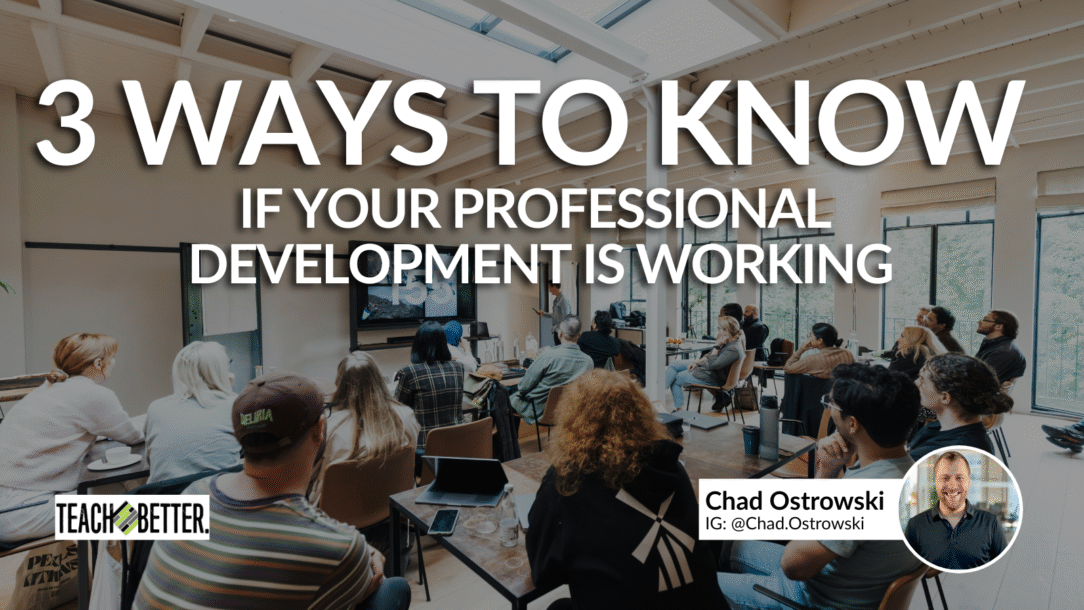Professional Development (PD) is everywhere. Workshops. Webinars. Book studies. PLCs. You’ve probably been through it all.
But here’s the question that nobody seems to ask out loud: “Is any of this actually working?”
Schools spend hours (and let’s be honest, a lot of money) on PD every year. But if it’s not leading to better outcomes for teachers or students…what’s the point?
I’ve seen, provided, and experienced professional development that transforms classrooms, and I’ve seen PD that just checks a box or fills time slot on a staff inservice day. If we want to create lasting change in schools, not just buzzwords and binders, we need to know how to recognize when PD is actually making a difference.
Here are 3 clear signs your PD is working — and what to do if it’s not.
1. Teachers Are Talking About It Outside the Session
If your PD session ends and the conversation keeps going in the hallway, in team meetings, even over lunch, that’s a good sign. Why? Because it means the content hit something real. Teachers don’t keep talking about fluff. They talk about what’s useful, what challenges their thinking, and what they believe could make their lives or their students’ lives better.
PD that works doesn’t end with a slideshow. It sparks curiosity, conversations, and collaboration. It also gives actionable steps towards progress and the end goal in mind.
Ask yourself:
-
Are teachers sharing takeaways with each other?
-
Are they asking questions or pushing deeper into the topic?
-
Is it showing up in PLCs or staff huddles without being forced?
Another great way to start evaluating this is ensuring that the PD ends with some sort of survey or exit slip that allows teachers to share their thoughts.
2. You See It in the Classroom
This is the big one. If the strategies or tools from PD never make it past the training room, it’s not working. Period.
The goal of professional development is professional growth and growth shows up in action. Whether it’s new instructional strategies, stronger classroom management, or even subtle shifts in how teachers assess students, you should be able to walk into a classroom and say, “Ah, that’s from the PD we did last month.”
It’s not about perfection. It’s about application. Are teachers testing things out? Are they making changes based on what they learned?
What to look for:
-
Exit tickets aligned to mastery goals
-
Increased student engagement or ownership
-
New tech tools being implemented with purpose
-
Teachers asking for feedback or support around the PD topic
If the classroom isn’t changing, the PD isn’t sticking. There is also a component of ensuring the goals of the learning and the PD are clear for staff BEFORE and AFTER the session.
[scroll down to keep reading]
3. It Feels Like Support, Not Another Initiative
PD that works doesn’t feel like a checklist or another thing to do. It feels like support. It gives teachers tools they can use right now, with real students, in real time.
The best PD:
-
Respects teachers’ time and expertise
-
Solves real problems they’re facing
-
Builds confidence instead of adding stress
If teachers walk out of PD thinking, “I can actually use this,” you’re doing it right. If they walk out thinking, “That was nice, but… when will I have time for this?” it’s back to the drawing board.
What If Your PD Isn’t Working?
First off, it’s okay. Not everything is going to work all the time. The answer isn’t more PD. It’s better PD.
- Ask teachers what they need.
- Follow up. Support the implementation.
- Focus on quality, not quantity.
- Make it a conversation, not a one-time event.
At the end of the day, professional development for teachers isn’t about checking a box. It’s about helping your teachers do what they do best…a little bit better.
Additional Note: Often times, the best PD is actually just providing teachers the time and space to dive deeper into a previous topic or training, rather than more “new” concepts being piled on.
Final Thought:
If we want schools to improve, we have to start by investing in the people who make them run. This means giving teachers the kind of PD that makes them feel empowered, equipped, and energized.
So next time you plan (or attend) a PD session, don’t just ask, “What are we learning?” Ask, “Is this going to change anything tomorrow?”
If the answer is yes, you’re on the right track.
About Chad Ostrowski
Chad Ostrowski is the co-founder of the Teach Better Team, and creator of The Grid Method. He is also a co-author of the Teach Better book. But Chad is a middle school science teacher at heart. He now travels the country sharing his story, working with teachers, schools, and districts to help them to reach more students. Chad is also a member of the Teach Better Speakers Network.



